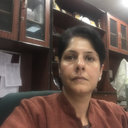Spermatogenic arrest in men with testicular hyperthermia.
Atslēgvārdi
Abstrakts
Sperm is produced by a highly complex and poorly understood differentiation process known as spermatogenesis. Occupational exposure to high temperatures adversely affect testicular function, causing partial or complete spermatogenic arrest. Dyers, cooks, blast furnace workers, and men with varicocele are known to develop testicular hyperthermia, which leads to oligoasthenoteratozoospermia (OAT) and azoospermia. Semen analysis of 122 infertile men (and 25 fertile controls), following the WHO guidelines, 1999, showed azoospermia in 106 men and oligozoospermia in 16 men. Twenty azoospermic and fourteen oligozoospermic men had high testiculoepididymal temperatures, either due to occupational exposure to high temperature or varicocele. All the 14 oligozoospermic men showed a very high percentage of sperm with abnormal morphology, impaired motility and they were subclassified as OAT group. Observations made in this study reiterates that high intratesticular temperature causes partial or complete spermatogenic arrest and may lead to increased production of morphologically abnormal sperm with impaired motility. This inverse relationship of sperm function with elevated temperature has implications in clinical medicine both in understanding pathological states and for therapeutic measures.


